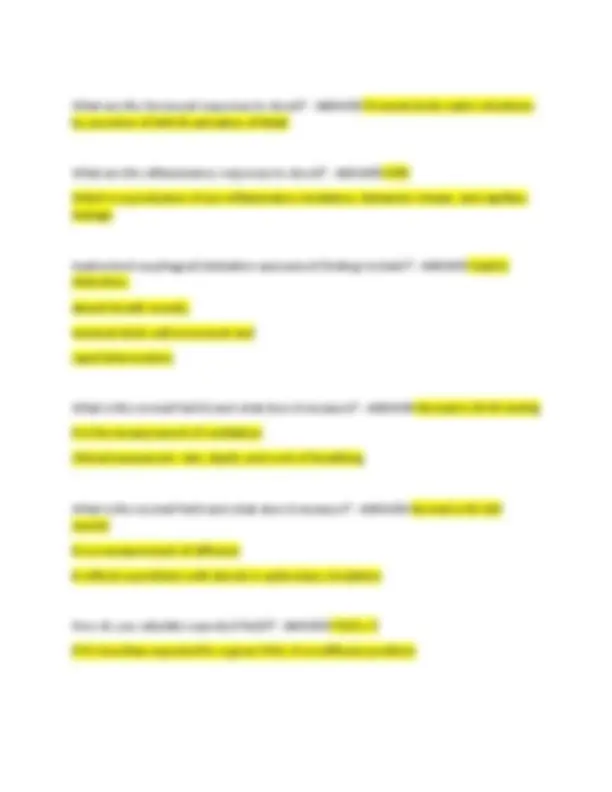
























Study with the several resources on Docsity

Earn points by helping other students or get them with a premium plan


Prepare for your exams
Study with the several resources on Docsity

Earn points to download
Earn points by helping other students or get them with a premium plan
Community
Ask the community for help and clear up your study doubts
Discover the best universities in your country according to Docsity users
Free resources
Download our free guides on studying techniques, anxiety management strategies, and thesis advice from Docsity tutors
A comprehensive review of trauma care concepts, covering topics such as pelvic fracture stabilization, femur fracture management, shock, and oxygen delivery. It presents a series of questions and answers, designed to test understanding of key principles and procedures in trauma care. Particularly useful for students and professionals in the medical field, offering a valuable resource for self-assessment and knowledge reinforcement.
Typology: Exams
1 / 30

This page cannot be seen from the preview
Don't miss anything!























What are the definitive options for pelvic fracture stabilization and hemorrhage control?
Dose of energy is? - ANSWER-The nature and amount of force Characteristic of wounding agent? - ANSWER-Type of energy and how it was applied Force - ANSWER-The dose of energy involved Which gender is the majority of trauma? - ANSWER-Male Incidence of trauma peaks at what age? - ANSWER-Teens and young adult Blunt trauma Classifications include? - ANSWER-MVA Auto vs. pedestrian Falls Struck by or against an object Trauma mortality based on organ system failure? - ANSWER-1 organ system failure=4% 2 organ system failures=32% 3 organ system failures=67% 4 organ system failures=90% What are the four collisions? - ANSWER-1. The vehicle
Pipes- site of defect is artery, veins or capillaries Fluid-intravascular, interstitial or intracellular VS in shock? - ANSWER-Narrow pulse pressure Tachycardia Low CO How many ATP molecules are produced with oxygen & glucose? - ANSWER-32 ATP molecules How many ATP molecules are produced without oxygen? - ANSWER-2 ATP molecules Normal pH? - ANSWER-Refernce range is 7.35-7.45, but actual normal range is 7.38-7. What is the footprint of shock? - ANSWER-Lactic Acidosis What 2 things affect the amount of oxygen availalbe to the cells? - ANSWER- Temperature & pH, which is the oxyhemoglobin dissociation curve Oxyhemoglobin dissociation shift to the right? - ANSWER-Acidosis, elevated temp More oxygen available to the cells Oxyhemoglobin dissociation curve shift to the left? - ANSWER-Hypothermia, alkalosis Less oxygen available to the cells H & H is a measure of? - ANSWER-It is a measure of hemodilution rather than blood loss.
What are the hormonal responses to shock? - ANSWER-Promote body water retentions by secretion of ADH & activation of RAAS What are the inflammatory responses to shock? - ANSWER-SIRS Which is a production of pro-inflammatory mediators, histamine release, and capillary leakage Inadvertent esophageal intubation assessment findings include? - ANSWER-Gastric distention, absent breath sounds, minimal chest wall movement and rapid deterioration What is the normal PaCO2 and what does it measure? - ANSWER-Normal is 35-45 mmHg It is the measurement of ventilation Clinical assessment- rate, depth, and work of breathing What is the normal PaO2 and what does it measure? - ANSWER-Normal is 80- 100 mmHG It is a measurement of diffusion It reflects a problems with alveoli or pulmonary circulation How do you calculate expected PaO2? - ANSWER-FIO2 x 5 If it's less than expected for a given FIO2, it is a diffusion problem
Best parameter to measure is P:F ration What is the best parameter to measure diffusion? - ANSWER-P:F ratio A simple pneumothorax presents a problems where in the cascade? - ANSWER- Ventilation Deflated section of the lung is not participating in gas exchange An isolated PTX can be treated with a CT in the 2nd ICS A tension pneuomothorax presents a problem where in the cascade? - ANSWER- Ventilation & CO Pulsus paradoxus and unilateral breath sounds Needle thoracostomy is only appropriate for? - ANSWER-Tension PTX A hemothorax presents a problem where in the cascade? - ANSWER-Ventilation and Hgb availability CT insertion at 4-5th ICS Blood loss is commonly the intercostal vessels Sub Q air is usually from? - ANSWER-It is usually from a tracheal or broncheal tear Fiberoptic bronchscopy best facilitates visualization below the cords MOST BLUNT TEARS OCCUR WITH IN 1" OF CARINA A massive PE symptoms? - ANSWER-Sudden change in mental status Neck vein distention Hemodynamic instability
Low O2 sat What chamber of the heart is most commoly injured in blunt trauma? - ANSWER-RV because the heart is rotated to the left Majority of injuires are myocardial contusions What is pericardial tamponade? - ANSWER-Occurs when fluid accumulates in the pericardial sac, as volume in the sac increases, volume in the chambers decreases. Temporarily overcome this by aggressive preload. Emergent surgical repair is the preferred treatment. Will see a narrow pulse pressure What test can be used to screen for thoracic aortic disruption? - ANSWER-Checking the BP in both arms, normally there should be less than 12 mHg difference in SBP between the arms. Avoid HTN to limit further dissection & avoid rupture What is permissive hypotension? - ANSWER-Keeping SBP 80- 90 Aggressvie fluid resuscitation disrupts new clots, dilutes blood, promotes coagulopathies, and aggravates endothelial leakage NOT APPRORIATE FOR TBI What are the 2 types of bleeding in a trauma patient? - ANSWER-Mechanical & Coagulopathic Mechanical requires surgery to fix hole Coagulopathic- later in ICU, TIC-trauma induced coagulopathy
What is MAP, and how is it calculated? - ANSWER-It is the organ & tissue perfusion pressure, the pressure the organs actually receive. Normal is >65. SBP+DBPx2/ What is shock index? - ANSWER-The relationship between SBP & heart rate required to maintain it (tachycardic compensation). HR divided by SBP, normal is 0.5-0. What are markers of tissue ischemia? - ANSWER-Lactate, pH, base deficit What are markers of hemostasis? - ANSWER-Clotting factors and H&H What do patients need who drop their BP after opiod administration? - ANSWER-They need volume What system is at greatest risk following initial stabilization? - ANSWER-Pulmonary What are hypotonic fluids? - ANSWER-Fluids that distribute throughout the body. Beneficial for dehydrated patients who need maintenance fluids. What are isotonic fluids? - ANSWER-Fluids that fill the vascular space, for those that need circulating volume replacement. 3/4 of this fluid quickly moves to interstitial spaces What are hypertonic fluids? - ANSWER-Fluids that helps pull fluid into the vascular space. Not good for patients at risk for fluid overload. 3% Saline
What is the ratio for crystalloid replacement to blood loss? - ANSWER-3 or 4 : 1 What is the magic pressure numbers? (ICP, ACS) - ANSWER-Approximately 20mm Hg is the pressure required to squeeze a capillary closed, regardless of where it is located, as soon as it closes, flow is impeded. What are early findings of end organ hypoperfusion? - ANSWER-Widenend pulse pressure (dropping diastolic pressure) Decrease U/O, decreased pulse ox, increase resp rate, restlessness What are SIRS criteria? - ANSWER-When 2 or more are met: Temp >38.3 or < RR >20, HR>90, PaCO2< 32 What is muscle compartment syndrome? - ANSWER-Elevated fascial compartment pressure, higher than arterial pressure. MOST prominent symptom is unrelieved pain What is the ankle-brachial pressure index? - ANSWER-SBP of ankle (lower leg) divided by SBP of brachial (upper arm), normal is 1, <0.8 means decreased flow What are symptoms of fat embolism syndrome and when do they occur? - ANSWER- Respiratory (tachypnea), neuro (agitation, anxiety) and dermal (petechial rash on chest), occur 12-72 hours after pelvic or long bone fractures
What is the most common site of an epidural hematoma? - ANSWER-Under the temporal bone, at site of the middle meningeal artery. Blood accumulates under the dura. On CT the hematoma appears convex What is the hallmark of an epidural hematoma? - ANSWER-A lucid interval after the injury, the as the bleeding puts more pressure on the brain-fixed & dilated pupils on the injured side, motor and sensory changes on the CONTRALATERAL side What is the cause of a Subdural hematoma? - ANSWER-Bleeding bridging vein is cause More common than epidural Blood on brain causes mechanical & chemical damage Will have same sided (ipsilateral) pupil dilation, contralateral weakness and sensory dysfunction What diagnostic study best identifies intracranial bleeds? - ANSWER-CT, fractures and bleeds are readily apparent on CT, concussions and diffuse injuries are not What is a cerebral contusion? - ANSWER-It is bruising of gray or white matter, that "blossom" over time What is the chief nursing concern with a cerebral contusion? - ANSWER-Neurological deterioration, reassess frequently Early findings include confusion, drowsiness, irritability, Disorientation, H/A, N&V What is a intraparenchymal hemorrhage? - ANSWER-It is bleeding within the brain tissue, cerebrum, cerebellum or brainstem. They are NOT routinely or easily evacuated.
What is a subarachnoid hemorrhage? - ANSWER-Usually a medical problem, not traumatic. Commonly caused by aneurysm rupture of AVM, often at circle of Willis What are the earliest signs of neurological deterioration? - ANSWER-Altered LOC, drowsiness, confusion, disorientation, H/A, agitation, N&V What is Secondary Brain injury? - ANSWER-Hypoxemia - SpO2 <90% Hypotension-SBP< What are the classic symptoms of brain herniation? - ANSWER-Cushing's Triad-irregular respirations, bradycardia, systolic hypertension (widened pulse pressure) What are cervial spine patients at greatest risk for? - ANSWER-Risk of respiratory comprimise C3, 4, 5- Keep diaphragm alive C3 function is not adequate to support ventilaton C4-can move diaphragm, minimally adequate C5-have diaphragm, lack intercostals What is a stable spinal cord injury? - ANSWER-It is not a threat to the cord, fracture of spinous or transverse processes What is an unstable spinal cord injury? - ANSWER-Fracture of vertebral body or ligament disruption What are negative effects of spinal/backboard immobilzation? - ANSWER-Airway comprimise, aspiration, ICP, pain, agitation, and skin breakdown
What is seen with Spinal Shock? - ANSWER-Temporary loss of spinal reflex activity "Limp Noodles" Resolves in hours-to-weeks As it resolves, pt develops contractures, spasticity & hyperreflexion What is neurogenic shock & what happens? - ANSWER-It is a distributive shock, causing massive vasodilation causing relative hypovolemia leading to inadequate tissue and organ perfusion. What symptoms are seen with neurogenic shock? - ANSWER-Bradycardia, hypotension, and widened pulse pressure What are injuries seen with lap belts only? - ANSWER-Lumbar spine fractures are a risk, and may not be evident until the patient stands How much volume can a pelvic fracture lose? - ANSWER-High risk of hemorrhage, and lose 750-5000 ml of blood How are open book pelvic fractures managed? - ANSWER-May be managed with external fixators How are lateral compression fractures managed? - ANSWER-Usally required ORIF How much hemorrhagic volume is associated with a humerus fracture? - ANSWER- 500 - 1500 ml How much hemorrhagic volume is associated with a tibia/fibula fracture? - ANSWER- 250 - 1000ml
How much hemorrhagic volume is associated with a femur fracture? - ANSWER- 500 - 3000 ml What are signs of uncompensated hemorrhagic shock? - ANSWER-Hypotension, tachycardia, Narrow pulse pressure, increased shock index What is the goal of permissive hypotension? - ANSWER-Keep SBP<90, Plug the holes, then replace volume with blood products What is the risk of aggressive fluid resuscitation? - ANSWER-It contributes to endothelial damage and capillary leakage What is the preferred fluid replacement with hemorrhagic loss? - ANSWER-Plasma is the preferred initial replacement. It has large molecules that stay in the vascular space. It also contains the clotting factors, which address bleeding. What is TIC-Trauma induced coagulopathy? - ANSWER-Is is stimulated by factors released from damaged cells, particularly the brain. Two tests that monitor it- TEG or ROTEM which provide real-time visual representation of clot formation and lysis What are the risks of Lefort Fractures? - ANSWER-They are associated with hemorrhage and airway comprimise due to blood in the airway, edema, and unsupported facial bones. Keep patient sitting up and leaning forward. If they have resp effort, apply O2 by any means. What is hyphema and how is it treated? - ANSWER-It is blood in the anterior chamber of the eye. Elevate HOB to pool blood in the lower portion of the anterior chamber. Avoid analgesics with antiplatelet effects - NSAIDS and ASA
What is the initial priority with a rib fracture? - ANSWER-Priority is pain management to allow for pulmonary toilet. It is the most important initial intervention. What is the most ominous finding in patients with flail chest? - ANSWER-The most ominous finding is oxygenation failure. Pulmonary contusions (the extent of diffusion defects) determine injury severity to a greater degree than the actual chest wall defect What is traumatic asphyxia? - ANSWER-It is a thoracic crushing condition that occurs when sudden blunt trauma to the chest forces retrograde blood blow through the superior vena cava into the head and neck What are the symptoms of traumatic asphyxia? - ANSWER-Petecial & subconjunctival hemorrhage. The face is swollen, the face and upper torso are discolored blue-red to black-blue. Discoloration and petechiae are prominent on eyelids, nose and lips What are symptoms of bowel contusions? - ANSWER-Include nausea, anorexia, mild diffuse abd pain, hypoactive bowel sounds How long do spleen injury patients have to avoid contact sports? - ANSWER-For up to 8 weeks What do spleenectomy patients have a lifetime risk of? - ANSWER-Pneumococcal sepsis and other infections What are symptoms of pancreatic trauma? - ANSWER-Nausea, vomiting, and epigastric pain. Amylase and lipase may provide information about pancreas status.
What are some infectious complications of bowel injuries? - ANSWER-Abscess formation, peritonitis, abdominal wall infections, and sepsis Why do trauma patients need nutritional support? - ANSWER-Without nourishment the villi atrophy, facilitation of bacterial translocation from the gut to the peritoneal cavity and into the blood What dietary needs do orthopedic trauma patients have? - ANSWER-Need to increase dietary protein, calcium, and Vitamin D What are the solid abdominal organs? - ANSWER-The liver, spleen, and kidneys. They are dense, highly vascular, non-elastic, and in a tough capsule. As long as the capsule is intact, hemorrhage is contained and solid organs will heal. How are hepatic lacerations managed? - ANSWER-Need serial abdominal exams, Hgb, liver enzyme levels, and coagulation studies What are the symptoms of diaphragmatic hernias? - ANSWER-Because the liver blocks migration of the contents on the right, a majority occur on the left. Patient will experience SOB, and bowel sounds may be auscultated in the chest What is Grey-Turner sign? - ANSWER-It is bruising along the flank and is anticipated 24- 48 hours after penetrating renal trauma What are the causes of ureteral injuries? - ANSWER-They are uncommon and is primarily the result of firearm, stab or impalement In trauma patients, what is the most common cause and treatment of renal failure? - ANSWER-Pre-renal failure is the case of "nothing in, nothing out". The problem is hypovolemia, treatment is fluids. Common shortly after injury.